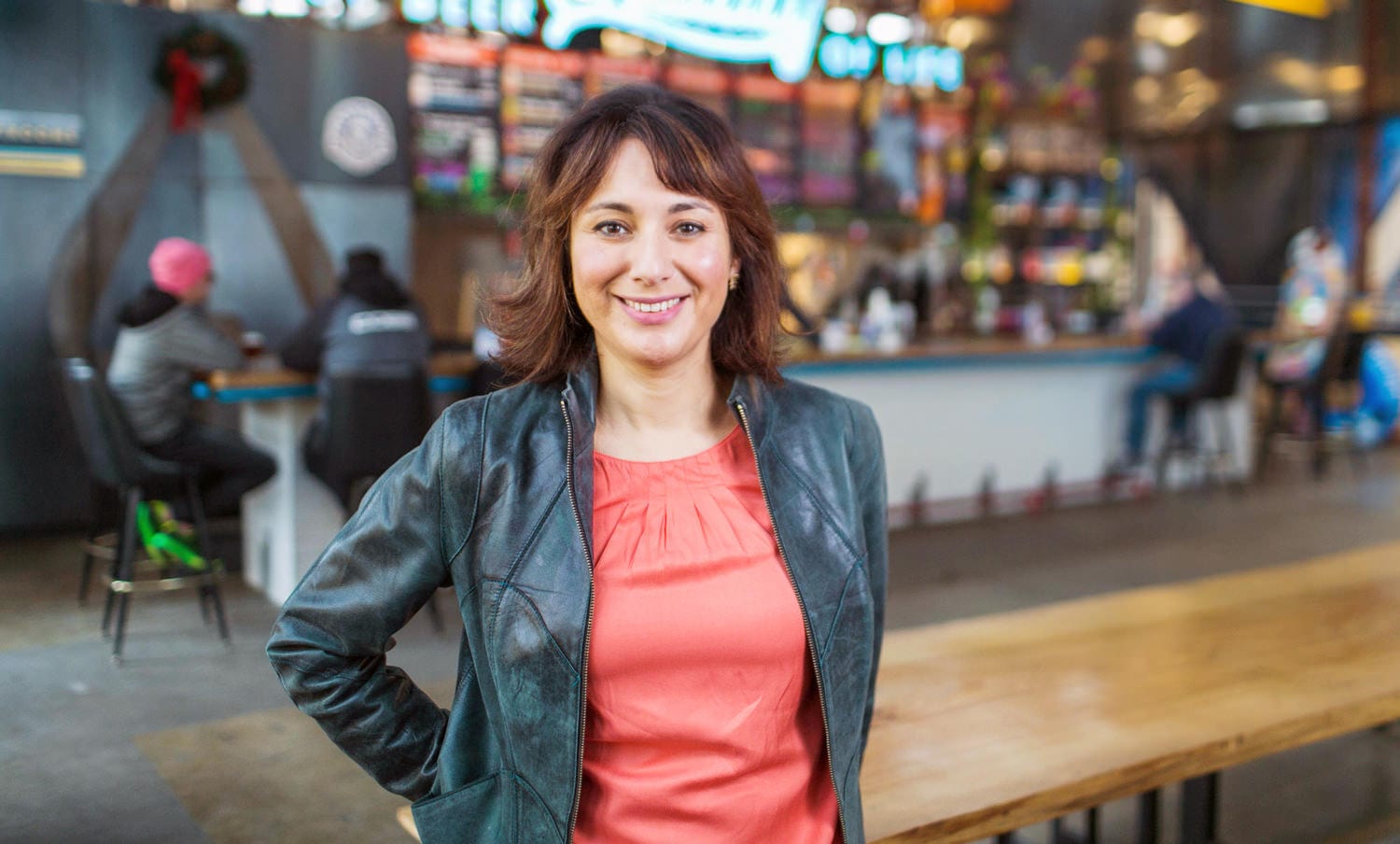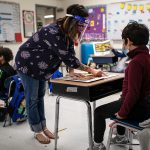When the Austin Independent School District threatened to close her son’s school in 2012, Gina Hinojosa decided to run for a seat on the school board to advocate for public education funding. She was elected that year, became president of the board in 2015 and is now a Texas state representative, making policy during a pandemic that has upended the country’s school systems for more than a year.
All 50 states closed schools to in-person instruction at some point in 2020. Millions of students began learning from home, a situation that forced many mothers to drop out of the workforce to supervise their children’s virtual education. Teachers, who are mostly women, shifted their work online and learned to navigate new technologies and new challenges, including families without the proper resources for virtual learning. Eventually, students began returning to in-person instruction, but many school districts found themselves in a debate about reopening — with many teachers unions pushing for continued remote learning until there are strict safety measures in place and some parents advocating for a return.
“This has become a culture war that schools don’t have anything to do with,” Hinojosa said. “They just want to teach kids and keep everyone safe. It puts needless pressure on our schools that are already very challenged to do their job.”
Hinojosa is one of many educators who have run for elected office, driven by a dissatisfaction with policy decisions that impacted teachers and their students. In 2018 — after statewide teacher strikes and protests in states including Arizona, Kentucky and West Virginia — an unprecedented number of teachers on both sides of the aisle ran for office. The 19th reached out to nearly two dozen elected Democrats and half a dozen Republicans, many of whom are still working educators, to discuss their impact in office and unique perspective on the school reopening debate. Eight Democratic women from across the country responded, revealing divisiveness and uncertainty among state legislators, school districts, educators, and families struggling to navigate shifting rules and guidelines.
State Sen. Laura Sturgeon of Delaware, currently chair of the Senate education committee, taught English literature and Spanish high school classes for more than two decades before she decided in 2018 that she could better help her students by running for office. She did both jobs at the same time for one year but found the workload “impossible to juggle” and retired with a partial pension.
“I did love teaching and taught for 25 years in the public schools, but I didn’t feel that my voice was heard when it came to education policy,” Sturgeon said. “I felt that teachers and students were the end users of all kinds of policies that came down from on high, but rarely were we asked or consulted or invited to the table. And it was frustrating.”
During her last decade of teaching in a public high school, Sturgeon described her classroom as “extremely chaotic, exhausting and overwhelming.” The class sizes were large, and nearly half of the students needed special education services. Sturgeon recalled students coming in with gunshot wounds — and one with a bullet still lodged in his arm.
“I was set up for failure, and my poor students couldn’t get the help they needed,” Sturgeon said. “… There’s all kinds of trauma that nobody is addressing, and it affects learning.”
Now, Sturgeon said, she uses her role as a legislator to be a champion for both teachers and their students — two constituencies that have been especially impacted during the pandemic. In Delaware, it’s up to individual districts to decide whether to hold classes in person, virtually or in a hybrid model. Sturgeon stands by teacher unions who don’t want to return to in-person instruction until community spread is significantly curtailed or every teacher is vaccinated.
“A lot of people think they know what schools need because they went to school,” Sturgeon said. “But educators would be able to say how bad policy, no matter how well-intentioned, would actually play out.”
A lot of people think they know what schools need because they went to school.
State Sen. Laura Sturgeon of Delaware
On March 2, President Joe Biden urged states to vaccinate all educators, school staff members and child care workers by the end of March. He said in-person learning should be treated “like the essential service that it is.” Some states, like Texas, started vaccinating school workers immediately, while others, like Massachusetts and Indiana, took longer.
But in Texas, that came on the same day that Gov. Greg Abbott, a Republican, lifted all coronavirus restrictions, including mandatory masks. Many school systems kept them in place as they scrambled to respond to the unexpected move.
“Biden’s decision to prioritize teachers and school staff is going to go a long way,” said Hinojosa, who has two children enrolled in public school who have been learning remotely for one year. “It’s the best thing we can do to get kids back in school. … I think I’m with most parents in this country when I say I’m ready for this to be over.”
Hinojosa said she understands both the emotional toll that the pandemic has had on students and their families and the challenges teachers are facing.
“We’re all exhausted, but teachers doubly so,” Hinojosa said. “They welcome a return to normal, a return to the classroom, but we need to give them the protections they need. I feel like the debate has been characterized as ‘in-person versus remote,’ but the real debate is are we going to give our schools what they need or not.”
In New Mexico, State Rep. Joy Garratt of New Mexico, the vice chair of the education committee, said there was no consideration for teachers to be vaccinated when schools started reopening for in-person instruction in January. Many teachers felt “disrespected,” and Garratt remained a strong advocate for required vaccinations for returning teachers.
“Everyone wants to go back and teach in person,” Garratt said. “But going back to school includes bus drivers, cafeteria workers, janitors and others. There are also a lot of multigenerational families in New Mexico, which makes unsafe conditions especially dangerous.”
Garratt retired from teaching social studies in 2020, after 25 years in the Albuquerque school district. Her time as a teacher overlapped with her legislative work for two “very challenging” years. She remembers being inspired to run during a field trip to the state Capitol with 60 eighth graders, when one of them asked if she would run for office. New Mexico is the only state where lawmakers receive no salary, and she found long-term substitutes while the legislature was in session.
“It was nice because as I taught, I could use my experience in the House with my students and use my experience in the classroom to inform legislation,” Garratt said.
State Rep. Natalie Figueroa, another legislator in New Mexico and a high school Spanish teacher, said the pandemic has illuminated how the U.S. educational system — with its emphasis on local control and decision making — is unlike those in other countries. This is apparent when looking at the variety of ways schools have responded and implemented safety protocols, Figueroa said.
The majority of teachers in New Mexico are older, unvaccinated and terrified to return to the classroom, Figueroa said. Parents, she added, seem to be “deeply divided on the issue.”
Figueroa, who took office in 2019, said having educator voices in the legislature brings a practicality to policy decisions. Teachers, she argued, understand how laws will play out in both urban and rural school districts.
State Sen. Mary Kunesh of Minnesota retired in November from her position as a library media specialist at an elementary school after balancing both positions became too difficult. During this past year, Kunesh said she lost two family members to the coronavirus. She feels strongly that students should get back to classrooms but that it should not be at the expense of teachers, custodians and other school employees.
“A lot of the work I do now is educating other lawmakers,” Kunesh said. “There are legislators that are trying to put in place mandates, bills and legislation who have never dealt with kids who were struggling because they’re homeless, hungry or don’t have clean clothes… I can give examples and tell stories that really move and motivate legislation.”
A lot of the work I do now is educating other lawmakers.
State Sen. Mary Kunesh of Minnesota
Melanie Wright, who was elected in Indiana 2014 and served three terms before losing her seat last year, has been a music teacher for more than three decades. Wright said her sixth-grade students in her small district have been attending classes in person for the entirety of the 2020-2021 academic year, barring a few days at the beginning of fall semester and around Thanksgiving. Schools in Indiana have been allowed to reopen for in-person instruction since July. The state encouraged superintendents to work with local public health officials to decide how to proceed.
“I find it so interesting that we finally get local control when it comes to a health issue,” Wright said. “We’re not given local control when it comes to testing, but when it comes to something that is out of our expertise, we’re told to go with it.”
Wright, like other educators in office, said she decided to run when a Senate bill stripped collective bargaining for unions — “a personal attack on my profession.” When she was elected in 2014, she was the only Democrat who was able to flip a Republican-held seat.
Assemblywoman Selena Torres of Nevada, a high school English teacher, said she decided to run for office in December 2017, prompted by systemic inequities in her classroom. As an elected official, Torres advocates for restorative justice in school discipline, more support for English language learners and now student safety during a pandemic.
“In light of the pandemic, what becomes a necessity in the workplace has to change,” Torres said. “Here in the legislative building, we have hand sanitizer in every corner of the building. Schools need to adapt and change, too. I hope we’re making the purchases that we need to keep the schools safe, like masks and other cleaning equipment.”
State Rep. Tina Bojanowski of Kentucky, a special education teacher, said she was “100 percent ready” to open schools for any teachers and students who feel it’s safe. Gov. Andy Beshear issued an executive order recommending all school districts offer some form of in-person instruction, effective March 1.
“I was very supportive of shutdowns last year and the start of this year,” Bojanowski said. “But it’s been a year, and the virus has not gone. We are going to have to live with this virus and what that’s going to look like in the classrooms … I’m ready.”






